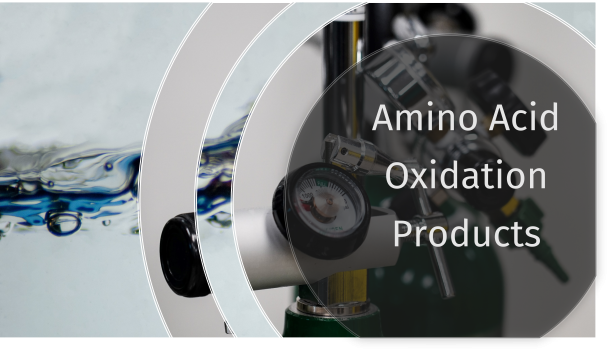Welcome to Iris Biotech
For better service please confirm your country and language we detected.

For better service please confirm your country and language we detected.

Thank you very much for your interest in our products. All prices listed on our website are ex-works, Germany, and may attract customs duties when imported.
You may/will be contacted by the shipping company for additional documentation that may be required by the US Customs for clearance.
We offer you the convenience of buying through a local partner, Peptide Solutions LLC who can import the shipment as well as prepay the customs duties and brokerage on your behalf and provide the convenience of a domestic sale.
Continue to Iris Biotech GmbHSend request to US distributorPublished on 23/03/2022

Oxidation is a known degradation pathway of proteins and peptides in vivo, as well as a major issue for certain amino acids during peptide synthesis, purification, formulation, and storage. This obviously minor modification may have a drastic impact on a peptide’s structure and function and causes product heterogeneity. Thus, it is important to monitor and identify the amount of oxidized variants. Especially Methionine (Met), Tryptophan (Trp) and Histidine (His) are prone to oxidation. In one of our previous blogs, we already focused on the oxidation of Met. Thus, within this newsletter, the main focus is on the oxidation of Trp and His. 2-Oxohistidine, the major product of histidine oxidation is reported as stable marker of oxidative damage in biological systems.

2-Oxohistidine, the major oxidation product of Histidine.
In the context of histidine, Iris Biotech also offers variations of its thiourea derivative ergothioneine (see related products), which is reported for its antioxidant and cytoprotective capabilities against a wide range of cellular stressors. Thus, ergothioneine can be incorporated into peptides to increase their antioxidant capacity.
In terms of Trp, the major oxidation products are oxindolylalanine (Oia), N-formylkynurenine (Nfk) and Kynurenine (Kyn).

Oxidation products of Tryptophan.
One of the main contributing factors for peptide oxidation are reactive oxygen species (ROS), such as singlet oxygen, hydrogen peroxide or hydroxyl radicals, which may be generated by light, photosensitizers, metals, or heat. In mammalian cells, as most of the oxidation products cannot be reduced by own processes, they are either degraded by the proteosome or accumulate within the cells. Oxidatively damaged proteins are known to be linked to pathogenesis such as, amongst others, age-related diseases like Alzheimer’s disease, Parkinson’s disease, and diabetes mellitus. Kyn derivatives and Oia appear also to play a key role in cataractogenesis (= avoidable blindness).
Besides, L-Kyn is also part of the depsipeptide daptomycin, a branched cyclic non-ribosomally assembled acidic lipopeptide, which is the first clinically approved antibiotic of this class used to fight a number of pathogenic Gram-positive bacteria.
Because of those severe effects that oxidized amino acid residues can have on proteins, there is need for further investigation. Iris Biotech’s available building blocks (see related products) will thus help to advance related studies.
References:
Reactivity and degradation products of tryptophan in solution and proteins; S. Bellmaine, A. Schnellbaecher, A. Zimmer; Free Radic. Biol. Med. 2020; 160: 696-718. https://doi.org/10.1016/j.freeradbiomed.2020.09.002.
Ergothioneine; antioxidant potential, physiological function and role in disease; I. K. Cheah, B. Halliwell; Biochim. Biophys. Acta 2012; 1822: 784-793. https://doi.org/10.1016/j.bbadis.2011.09.017.
Mass spectrometric identification of oxidative modifications of tryptophan residues in proteins: chemical artifact or post-translational modification? I. Perdivara, L. J. Deterding, M. Przybylski, K. B. Tomer; J. Am. Soc Mass Spectrom. 2010; 21(7): 1114-1117. https://doi.org/10.1016/j.jasms.2010.02.016.
Selective Tryptophan Oxidation of Monoclonal Antibodies: Oxidative Stress and Modeling Prediction; J. A. Pavon, L. Xiao, X. Li, J. Zhao, D. Aldredge, E. Dank, A. Fridman, Y.-H. Liu; Anal. Chem. 2019; 91: 2192-2200. https://doi.org/10.1021/acs.analchem.8b04768.
Oxidation of Free Tryptophan and Tryptophan Residues in Peptides and Proteins; T. J. Simat, H. Steinhart; J. Agric. Food Chem. 1998; 46(2): 490-498. https://doi.org/10.1021/jf970818c.
Mass spectrometric characterization of peptides containing different oxidized tryptophan residues; T. Todorovski, M. Fedorova, R. Hoffmann; J. Mass Spec. 2011; 46(10): 1030-1038. https://doi.org/10.1002/jms.1984.
Synthesis of peptides containing 5-hydroxytryptophan, oxindolylalanine, N-formylkynurenine and kynurenine; T. Todorovski, M. Fedorova, L. Hennig, R. Hoffmann; J. Pept. Sci. 2011; 17(4): 256-262. https://doi.org/10.1002/psc.1322.
Synthesis and Derivatization of Daptomycin: A Chemoenzymatic Route to Acidic Lipopeptide Antibiotics; J. Grünewald, S. A. Sieber, C. Mahlert, U. Linne, M. A. Marahiel; J. Am. Chem. Soc. 2004; 126(51): 17025-17031. https://doi.org/10.1021/ja045455t.
Structural Characterization of New Microcystins Containing Tryptophan and Oxidized Tryptophan Residues; J. Puddick, M. R. Prinsep, S. A. Wood, C. O. Miles, F. Rise, S. C. Cary, D. P. Hamilton, A. L. Wilkins; Mar. Drugs 2013; 11(8): 3025-3045. https://doi.org/10.3390/md11083025.
Probing the Tryptophan Environment in Therapeutic Proteins: Implications for Higher Order Structure on Tryptophan Oxidation; G. V. Barnett, G. Balakrishnan, N. Chennamsetty, L. Hoffman, J. Bongers, L. Tao, Y. Huang, T. Slaney, T. K. Das, A. Leone, S. R. Kar; J. Pharm. Sci. 2019; 108(6): 1944-1952. https://doi.org/10.3390/md11083025.
Synthesis of peptides containing 2‐oxohistidine residues and their characterization by liquid chromatography‐tandem mass spectrometry; C.‐F. Huang, Y.‐H. Liu, H.‐C. Tai; J. Pept. Sci. 2015; 21: 114-119. https://doi.org/10.1002/psc.2735.